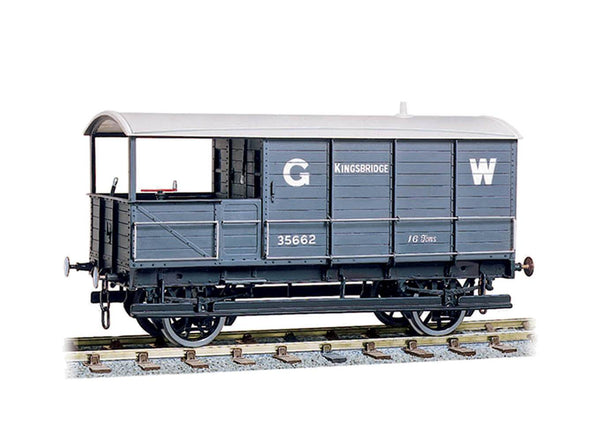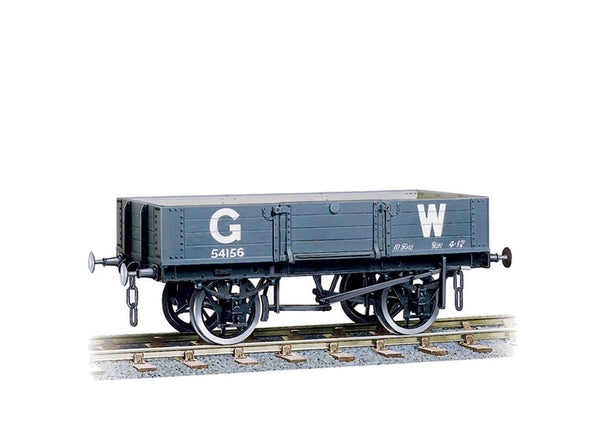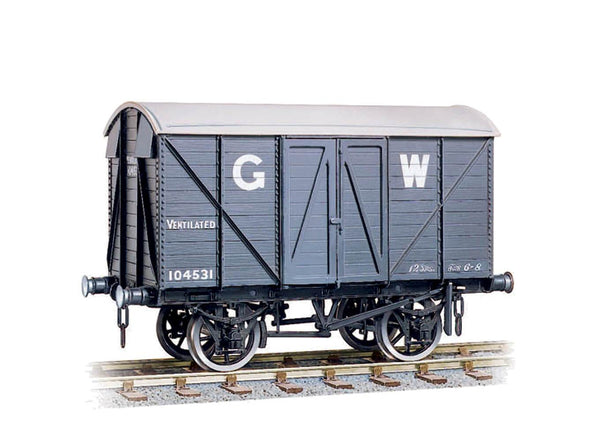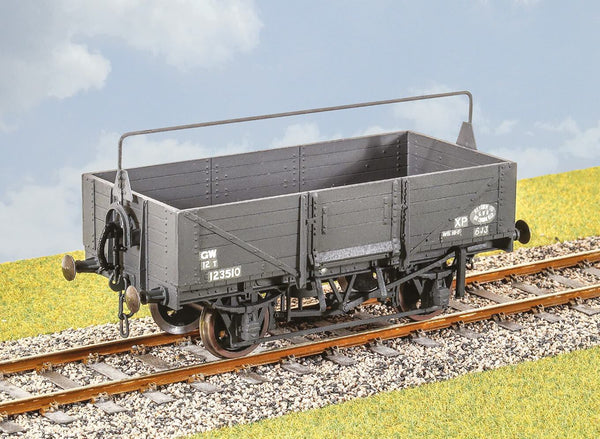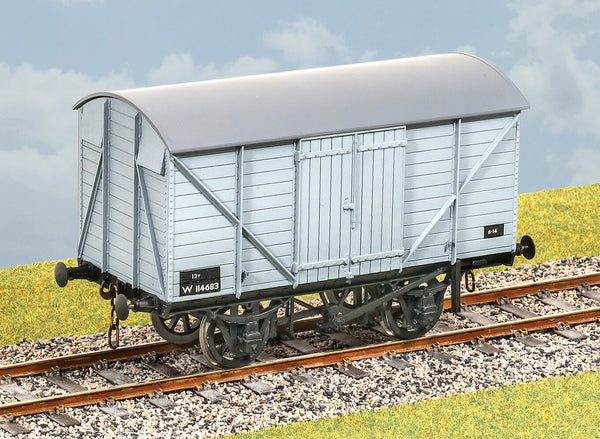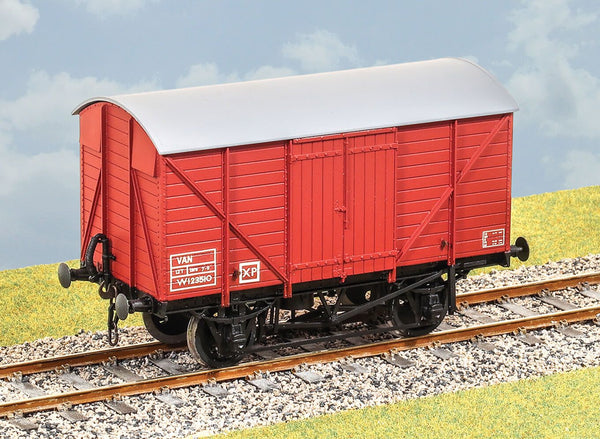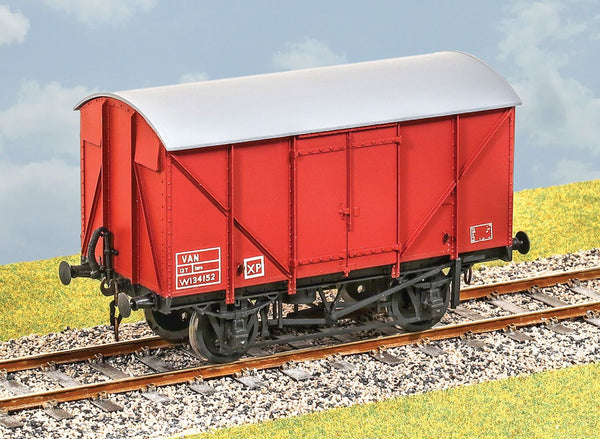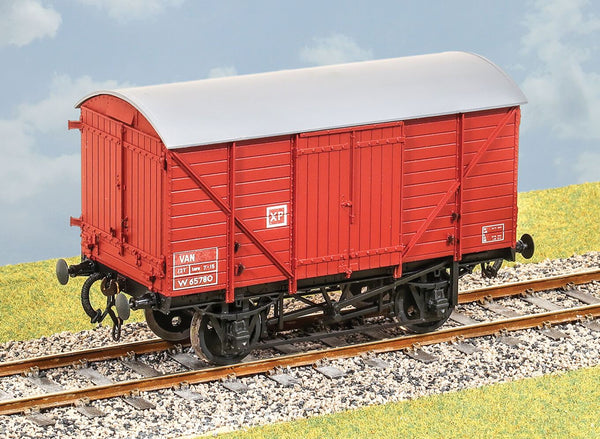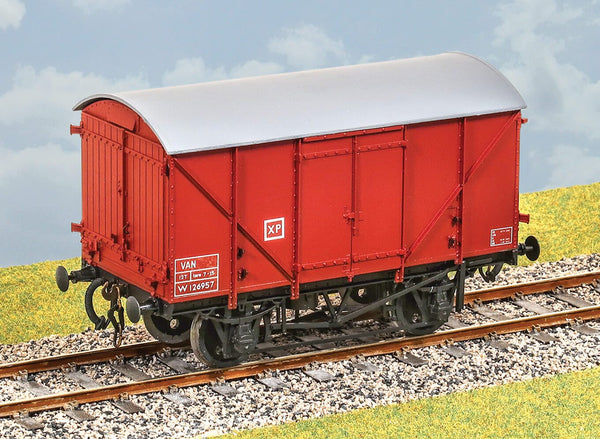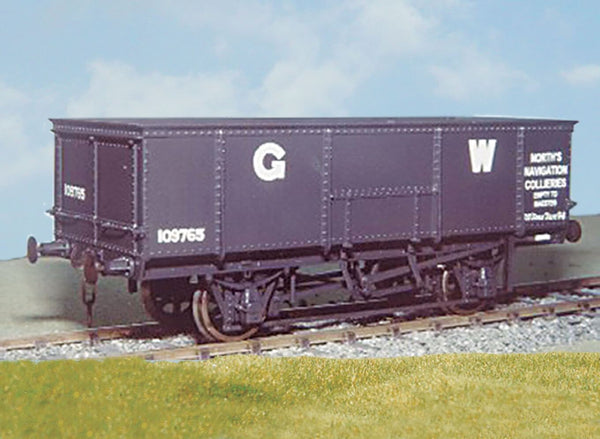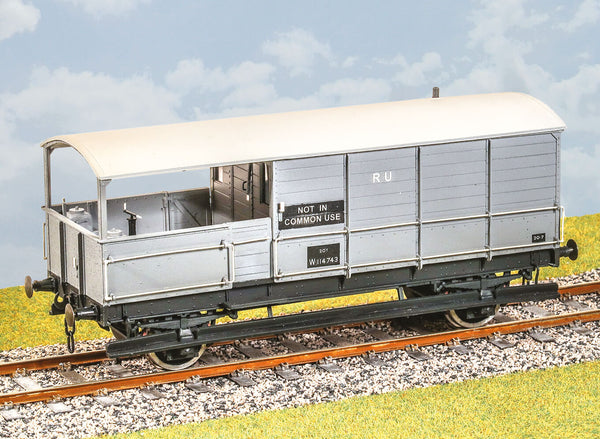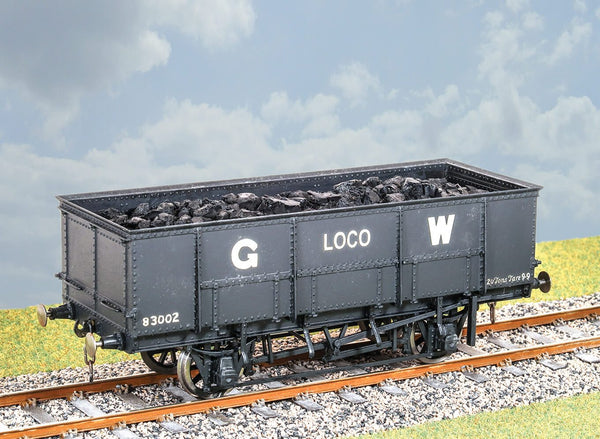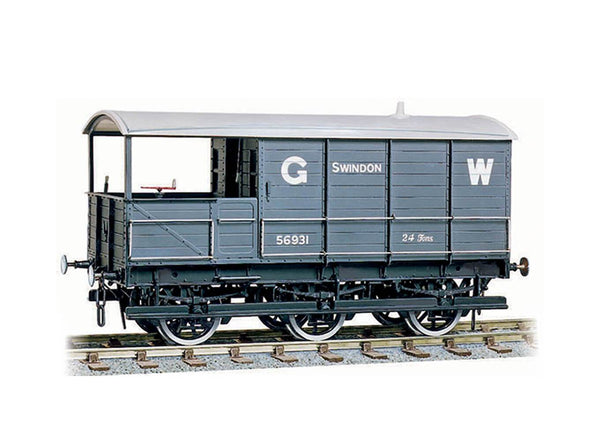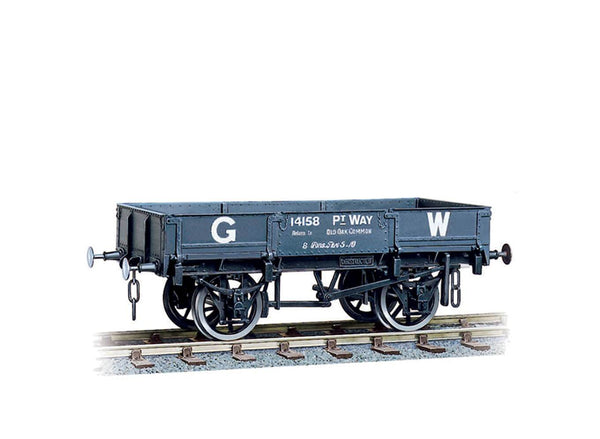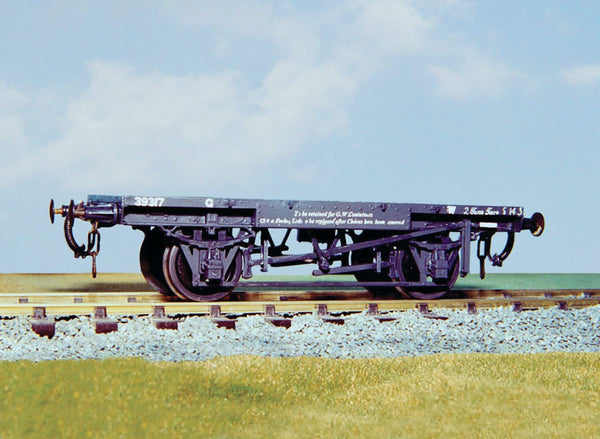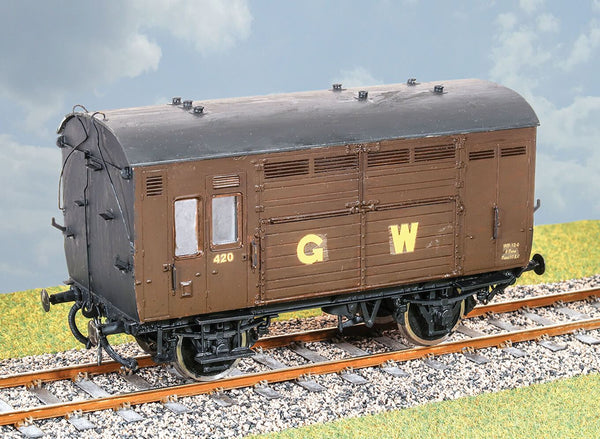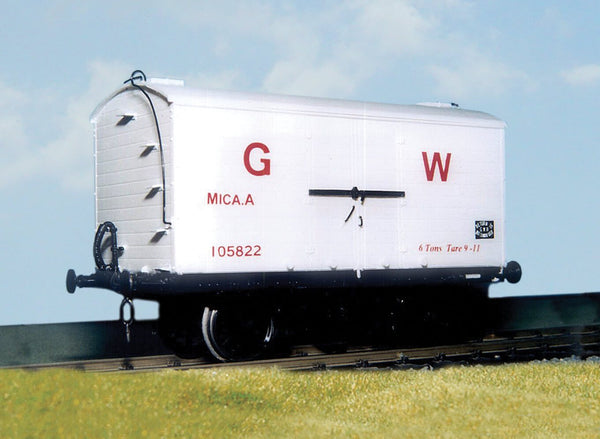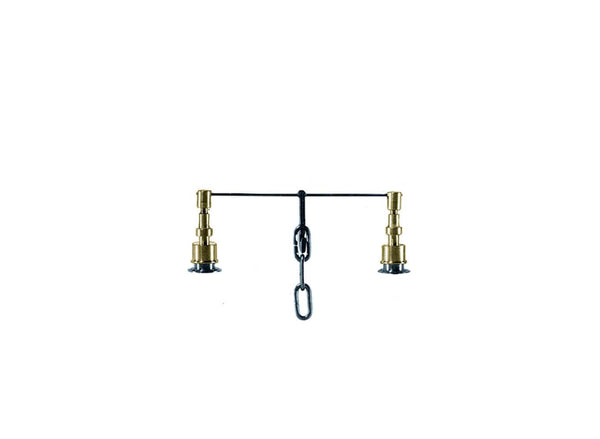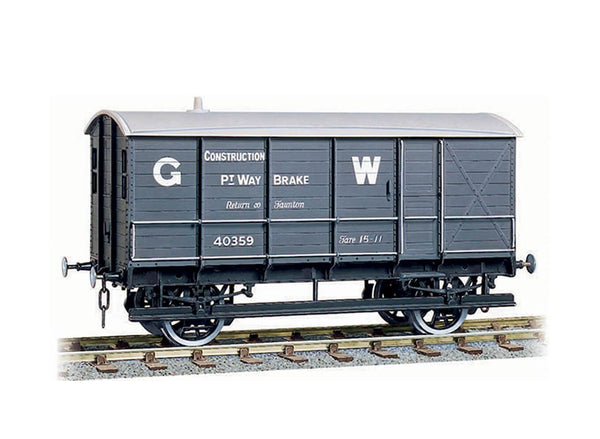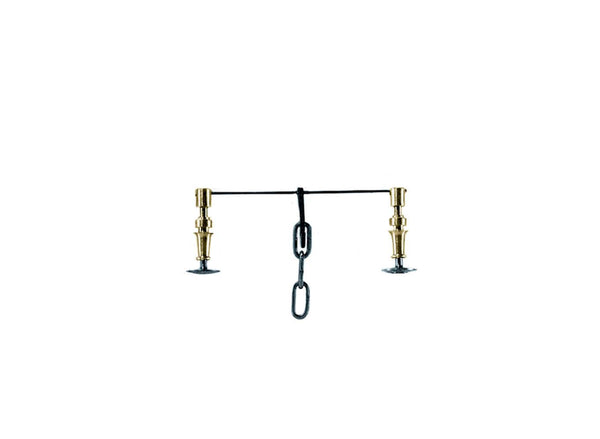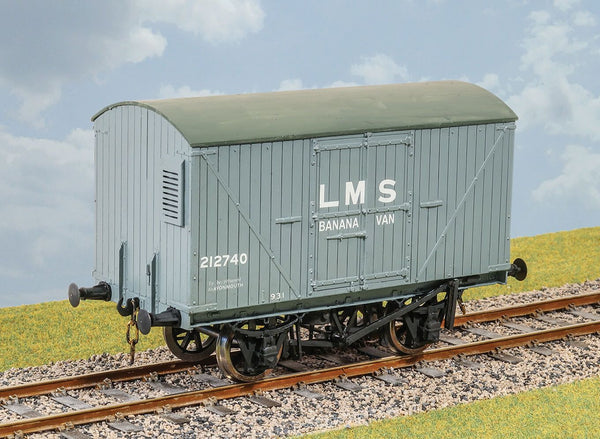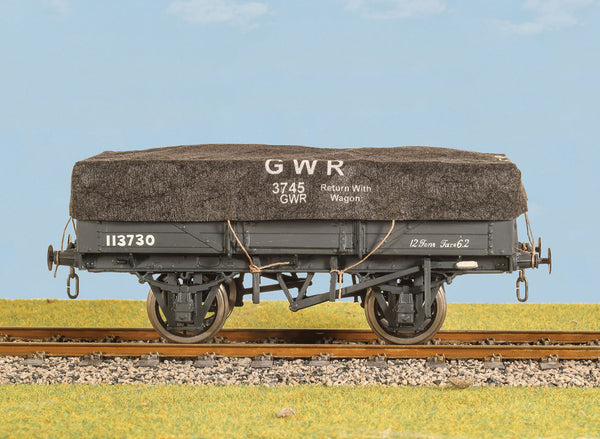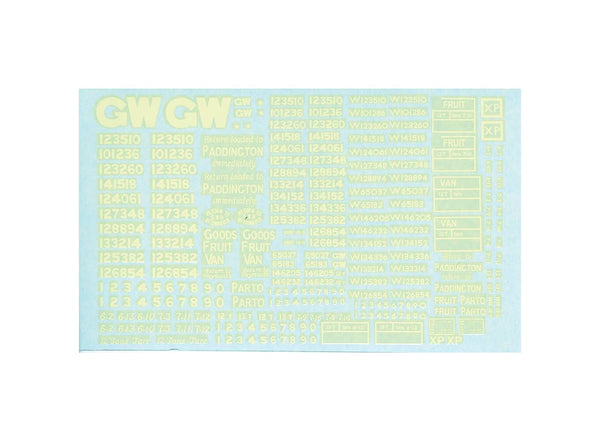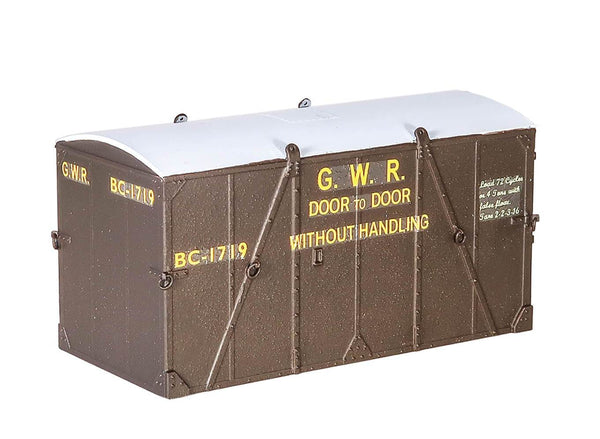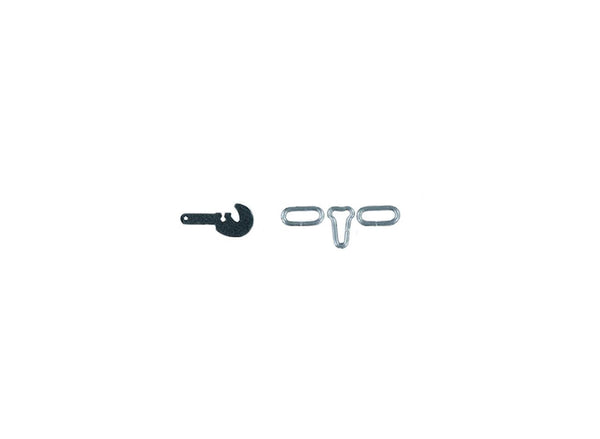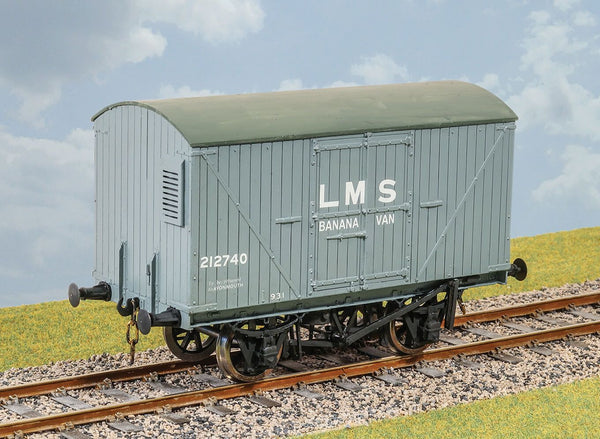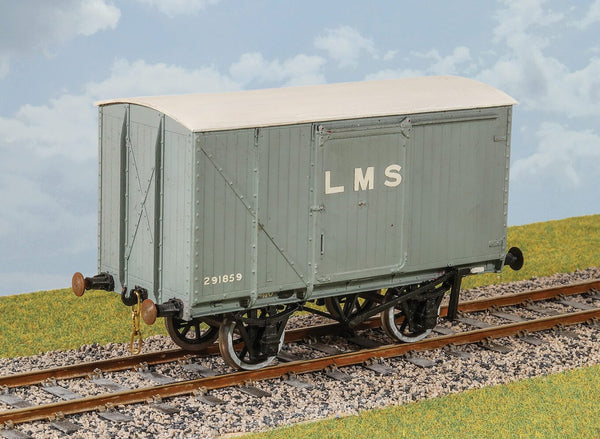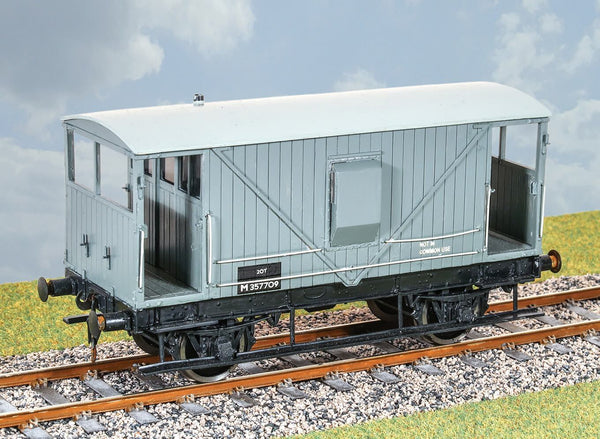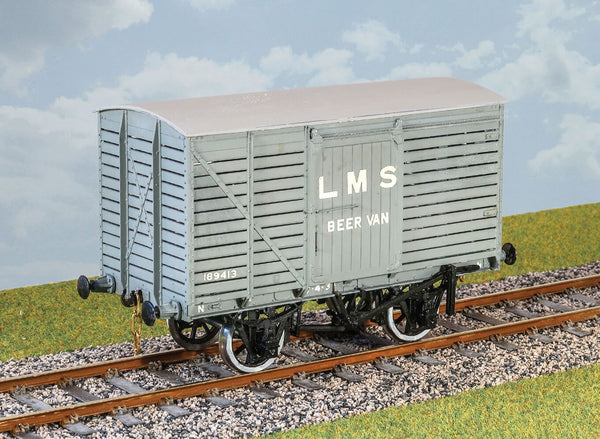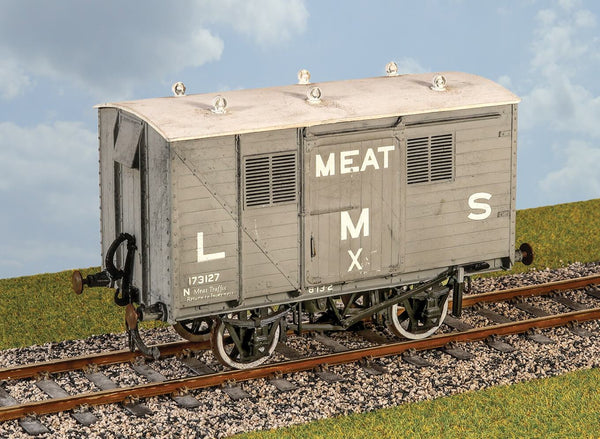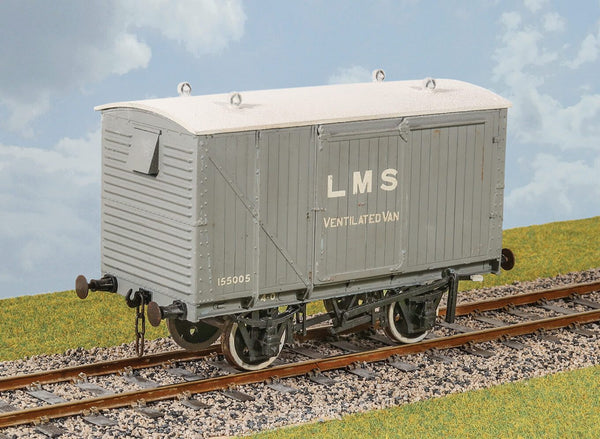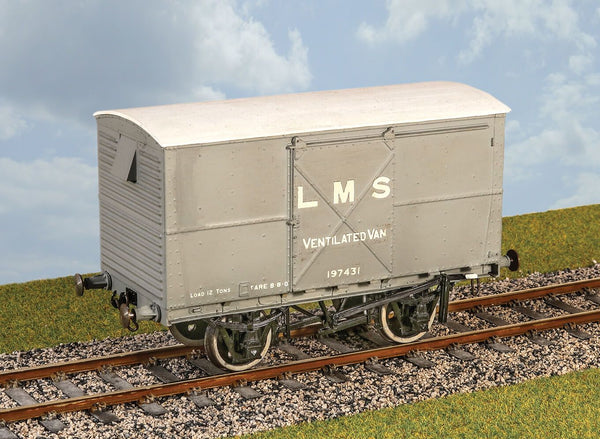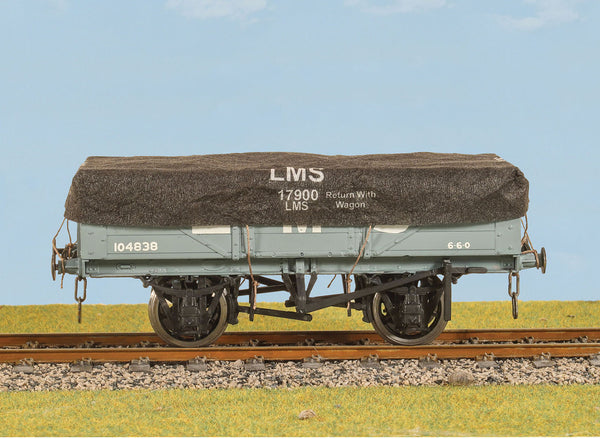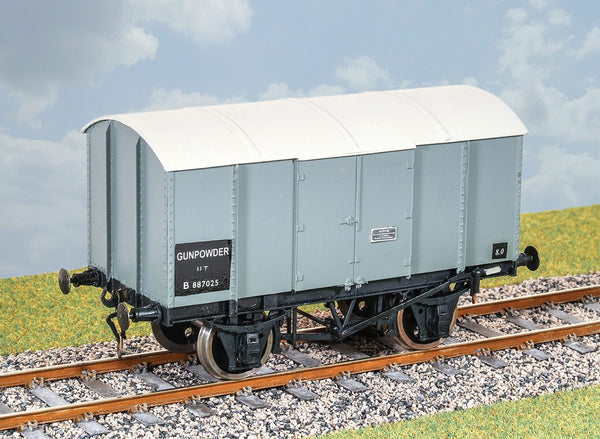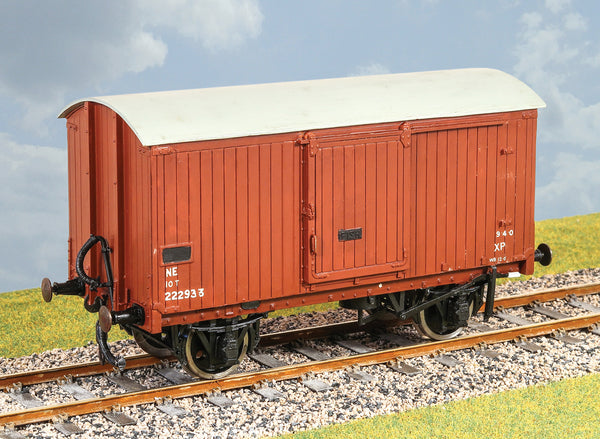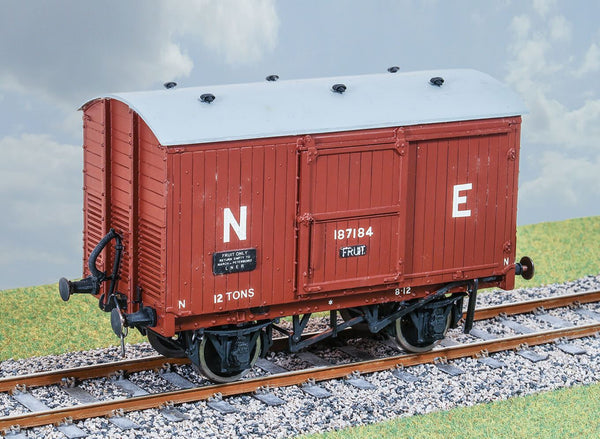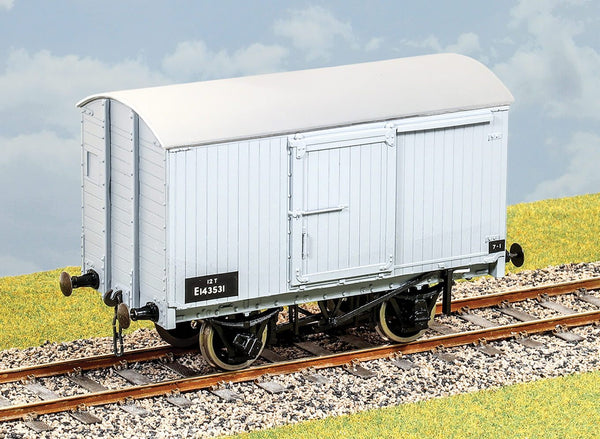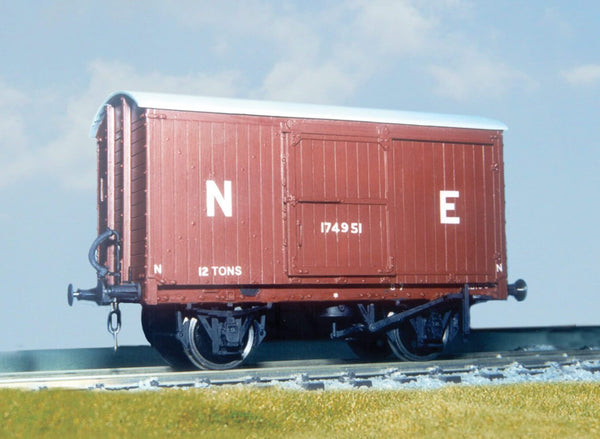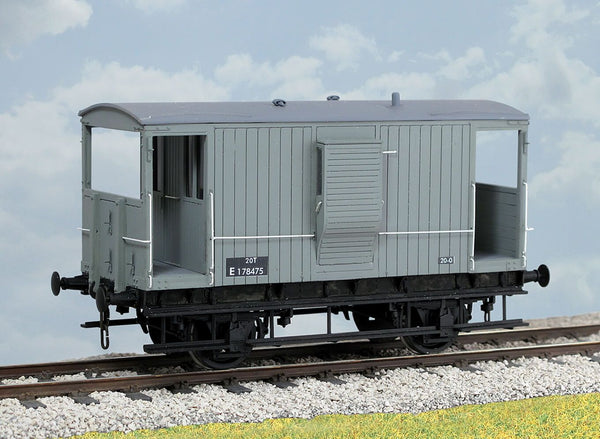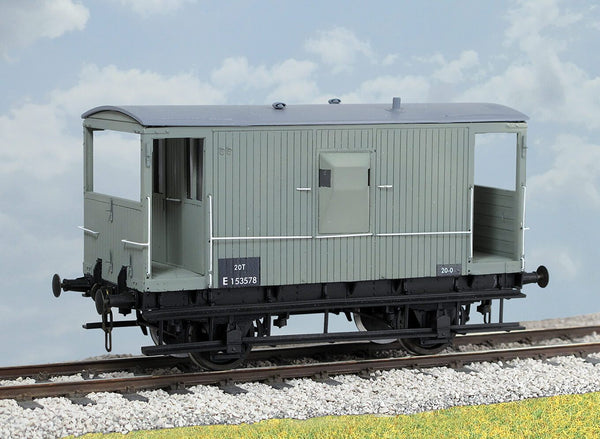BROWSE PECO PRODUCTS
Browse through our complete product portfolio.
148 Products Found
GVT Open Wagons (3) Laser-cut kits (NG7)
Laser-cut wagon kit of 3 x 4-wheel narrow gauge open wagons found at many industrial locations.
GWR 'Toad' Brake Van
Iconic GWR Goods Brake Van. Unlike other companies' brake vans, the GWR's unique single verandah design meant that they had to be turned on a turntable before the return journey. Easy to assemble from the correctly coloured injection moulded components (no painting necessary). Kits include Transfers. Buffers are sprung and 3-link couplings are included on all models, while the BR wagons also feature working axlebox springs and moveable brake levers. Fine scale metal tyred wheels on pin-point axles supplied, spoked for the GWR wagons or 3-hole disc for the BR types. Fully illustrated instructions included.
GWR 10ton 4 Plank Open Wagon
Several thousand of these wagons were built between 1888 and 1902. Kit features a pair of working central side-drop doors. Easy to assemble from the correctly coloured injection moulded components (no painting necessary). Kits include Transfers. Buffers are sprung and 3-link couplings are included on all models, while the BR wagons also feature working axlebox springs and moveable brake levers. Fine scale metal tyred wheels on pin-point axles supplied, spoked for the GWR wagons or 3-hole disc for the BR types. Fully illustrated instructions included.
GWR 10ton Ventilated Box Van
These vans were in general use for transporting perishable traffic from 1925. Some were converted for banana traffic, others were designated exclusively for fish. Kit includes a choice of different ventilators to suit the different uses. Easy to assemble from the correctly coloured injection moulded components (no painting necessary). Kits include Transfers. Buffers are sprung and 3-link couplings are included on all models, while the BR wagons also feature working axlebox springs and moveable brake levers. Fine scale metal tyred wheels on pin-point axles supplied, spoked for the GWR wagons or 3-hole disc for the BR types. Fully illustrated instructions included.
GWR 12/13ton Open Goods Wagon
Dia. O32: over 10,000 unfitted built (1933 – 1940); O33: 948 built with vacuum brake and tarpaulin rails. Most lasted into the 1970s, with some featuring fabricated steel strengthening. The kit covers all variants. Transfers for GWR and BR. These finely moulded plastic wagon kits come complete with pin point axle wheels and bearings, 3 link couplings and transfers. This kit is supplied with pre-coloured moulded parts although painting can improve the appearance. Additional parts to enable the vehicle to be modelled incorporating modifications made to the prototypes during their working life are included where appropriate.
GWR 12ton Covered Goods Wagon
950 wagons of this design were built between 1929 and 1933. Withdrawal took place in the early 1960s. These wagons were regarded as ‘common user’ so would have been found across the whole network. Transfers for GWR and BR. These finely moulded plastic wagon kits come complete with pin point axle wheels and bearings, 3 link couplings and transfers. This kit is supplied with pre-coloured moulded parts although painting can improve the appearance. Additional parts to enable the vehicle to be modelled incorporating modifications made to the prototypes during their working life are included where appropriate.
GWR 12ton Covered Goods Wagon
Dia. V24: hand brake only (1933 – 1943); V23: vacuum brakes (1933 - 1941); V26, known as ‘PARTO’ was as a V23 with internal partitions (1935 – 1939). Many lasted into the 1970s. Transfers for GWR and BR. These finely moulded plastic wagon kits come complete with pin point axle wheels and bearings, 3 link couplings and transfers. This kit is supplied with pre-coloured moulded parts although painting can improve the appearance. Additional parts to enable the vehicle to be modelled incorporating modifications made to the prototypes during their working life are included where appropriate.
GWR 12ton Covered Goods Wagon
Plywood body construction came about as a result of a shortage of wooden planks at the end of the last war. A total of 1,100 vans were built, 350 with only a hand brake (diagram V37), which eventually had vacuum brakes retro-fitted. They lasted into the 1970s. Transfers for GWR and BR.These finely moulded plastic wagon kits come complete with pin point axle wheels and bearings, 3 link couplings and transfers. This kit is supplied with pre-coloured moulded parts although painting can improve the appearance. Additional parts to enable the vehicle to be modelled incorporating modifications made to the prototypes during their working life are included where appropriate.
GWR 12ton Fruit Van
200 of these vans were built 1937/38 to convey Guernsey tomatoes. They were also used for other fruit and vegetable traffic. The fleet lasted into the 1970s, being used for general merchandise outside of the season. Transfers for GWR and BR. These finely moulded plastic wagon kits come complete with pin point axle wheels and bearings, 3 link couplings and transfers. This kit is supplied with pre-coloured moulded parts although painting can improve the appearance. Additional parts to enable the vehicle to be modelled incorporating modifications made to the prototypes during their working life are included where appropriate.
GWR 12ton Motor Car Van
350 of these were built between 1933 and 1936. Their telegraphic code was MOGO. The main traffic was from Morris Cowley, but might also have been used for general merchandise. All were withdrawn in the 1960s. Transfers for GWR and BR. These finely moulded plastic wagon kits come complete with pin point axle wheels and bearings, 3 link couplings and transfers. This kit is supplied with pre-coloured moulded parts although painting can improve the appearance. Additional parts to enable the vehicle to be modelled incorporating modifications made to the prototypes during their working life are included where appropriate.
GWR 12ton Motor Car Van
Similar to diagram G31, these wagons were built in 1946 and 1947, but with a plywood body. They lasted into the 1960s. Transfers for GWR and BR. These finely moulded plastic wagon kits come complete with pin point axle wheels and bearings, 3 link couplings and transfers. This kit is supplied with pre-coloured moulded parts although painting can improve the appearance. Additional parts to enable the vehicle to be modelled incorporating modifications made to the prototypes during their working life are included where appropriate.
GWR 13ton Open Goods Wagon
Almost 2,000 of these wagons were built between 1924 and 1929. The design was one of the first produced by the GWR using Railway Clearing House spec brake gear. Many survived into 1960s. These finely moulded plastic wagon kits come complete with pin point axle wheels and bearings, 3 link couplings and transfers. This kit is supplied with pre-coloured moulded parts although painting can improve the appearance. Additional parts to enable the vehicle to be modelled incorporating modifications made to the prototypes during their working life are included where appropriate.
GWR 20ton Felix Pole Coal Wagon
Almost 1,000 of these high capacity wagons were built in the 1920s for Welsh coal traffic. Rerated to a 21-ton capacity wagon during the Second World War, they were in traffic until the 1960s. Transfers for GWR and BR, and for Norths Navigation Collieries. These finely moulded plastic wagon kits come complete with pin point axle wheels and bearings, 3 link couplings and transfers. This kit is supplied with pre-coloured moulded parts although painting can improve the appearance. Additional parts to enable the vehicle to be modelled incorporating modifications made to the prototypes during their working life are included where appropriate.
GWR 20ton Goods Brake Van
221 of these vans were built between 1927 and 1931. Seen all over the GWR, and later BR Western Region. Examples lasted until the 1960s. Transfers for GWR and BR. These finely moulded plastic wagon kits come complete with pin point axle wheels and bearings, 3 link couplings and transfers. This kit is supplied with pre-coloured moulded parts although painting can improve the appearance. Additional parts to enable the vehicle to be modelled incorporating modifications made to the prototypes during their working life are included where appropriate.
GWR 20ton Loco Coal Wagon
Converted from the “Felix Pole” wagons (PS41), 200 were so treated in 1934-35, to convey coal to GWR locomotive sheds. Featuring extra side doors, they joined the general coal fleet in the 1950s. Transfers for GWR and BR. These finely moulded plastic wagon kits come complete with pin point axle wheels and bearings, 3 link couplings and transfers. This kit is supplied with pre-coloured moulded parts although painting can improve the appearance. Additional parts to enable the vehicle to be modelled incorporating modifications made to the prototypes during their working life are included where appropriate.
GWR 24ton Six-wheel Brake Van
On heavy unfitted coal trains form the Welsh Valleys to London, 6 wheels and 8 tons of extra weight were required to produce sufficient braking force to keep the train under control. Easy to assemble from the correctly coloured injection moulded components (no painting necessary). Kits include Transfers. Buffers are sprung and 3-link couplings are included on all models, while the BR wagons also feature working axlebox springs and moveable brake levers. Fine scale metal tyred wheels on pin-point axles supplied, spoked for the GWR wagons or 3-hole disc for the BR types. Fully illustrated instructions included.
GWR 8ton Steel Permanent Way Wagon
These rugged wagons were used on track maintenance trains together with the Permanent Way Brake Van (W602). Kit features 4 working side-drop doors. Easy to assemble from the correctly coloured injection moulded components (no painting necessary). Kits include Transfers. Buffers are sprung and 3-link couplings are included on all models, while the BR wagons also feature working axlebox springs and moveable brake levers. Fine scale metal tyred wheels on pin-point axles supplied, spoked for the GWR wagons or 3-hole disc for the BR types. Fully illustrated instructions included.
GWR Container Wagon
Standard GWR container (CONFLAT) wagon, as used in kit PS39, but without the container. Transfers for GWR and BR. These finely moulded plastic wagon kits come complete with pin point axle wheels and bearings, 3 link couplings and transfers. This kit is supplied with pre-coloured moulded parts although painting can improve the appearance. Additional parts to enable the vehicle to be modelled incorporating modifications made to the prototypes during their working life are included where appropriate.
GWR Container Wagon with 'B' Cont.
This was the standard GWR container wagon (CONFLAT) from 1933 to 1939. Examples lasted into the 1970s. The container supplied with this kit was of a type used to convey bicycles, and is also available separately (PS74). Wagon and container transfers for GWR and BR. These finely moulded plastic wagon kits come complete with pin point axle wheels and bearings, 3 link couplings and transfers. This kit is supplied with pre-coloured moulded parts although painting can improve the appearance.. Additional parts to enable the vehicle to be modelled incorporating modifications made to the prototypes during their working life are included where appropriate.
GWR Horse Box Wagon
300 of these vehicles were built in the 1920s, lasting into the 1950s and 60s. They were used to carry horses to racecourses and stables, often marshalled into passenger and parcels trains. Transfers for GWR and BR. These finely moulded plastic wagon kits come complete with pin point axle wheels and bearings, 3 link couplings and transfers. This kit is supplied with pre-coloured moulded parts although painting can improve the appearance. Additional parts to enable the vehicle to be modelled incorporating modifications made to the prototypes during their working life are included where appropriate.
GWR Mica Insulated Van
In 1929, 54 of these vans were built to carry meat in chilled conditions. The hoppers inside were filled with “Drikeld” solid carbon dioxide through characteristic roof vents. They lasted into the 1960s, some being converted into “TEVAN” vans (PS48). Transfers for GWR and BR. These finely moulded plastic wagon kits come complete with pin point axle wheels and bearings, 3 link couplings and transfers. This kit is supplied with pre-coloured moulded parts although painting can improve the appearance. Additional parts to enable the vehicle to be modelled incorporating modifications made to the prototypes during their working life are included where appropriate.
GWR Parallel Shank Buffers
0 Gauge Chassis kits and Accessories for scratchbuilders and kit modification. This pack contains sufficient components to assemble four buffers and two 3- link couplings. Three-link chain couplings, with no means of drawing the wagons together, were used to form the peculiarly British "loose coupled" freight train: since such trains were not fitted with an automatic through-train braking system there were no pipes to connect between the vehicles. Control of the train was assisted by the guard's van at the rear of the train, or in certain cases a series of vans spaced along the train, which were used to keep the couplings taut and therefore also helped prevent snapped couplings. Such trains travelled at low speeds and were finally phased out in the 1970s.
GWR Permanent Way Brake Van
The GWR built these special brake vans between 1890 and 1900, for use on track maintenance trains. They have end windows instead of the usuall verandah. Easy to assemble from the correctly coloured injection moulded components (no painting necessary). Kits include Transfers. Buffers are sprung and 3-link couplings are included on all models, while the BR wagons also feature working axlebox springs and moveable brake levers. Fine scale metal tyred wheels on pin-point axles supplied, spoked for the GWR wagons or 3-hole disc for the BR types. Fully illustrated instructions included.
GWR Tapered Shank Buffers
0 Gauge Chassis kits and Accessories for scratchbuilders and kit modification. This pack contains sufficient components to assemble four buffers and two 3- link couplings. Three-link chain couplings, with no means of drawing the wagons together, were used to form the peculiarly British "loose coupled" freight train: since such trains were not fitted with an automatic through-train braking system there were no pipes to connect between the vehicles. Control of the train was assisted by the guard's van at the rear of the train, or in certain cases a series of vans spaced along the train, which kept the couplings taut and therefore also helped prevent snapped couplings. Such trains travelled at low speeds and were finally phased out in the 1970s.
GWR Tevan Goods Van
These vans were converted from Mica Insulated Vans in 1938 (see PS49). They carried tea and coffee from the Lyons depot at Greenford into the 1960s. They featured a zinc-lined body. Transfers for GWR and BR. These finely moulded plastic wagon kits come complete with pin point axle wheels and bearings, 3 link couplings and transfers. This kit is supplied with pre-coloured moulded parts although painting can improve the appearance. Additional parts to enable the vehicle to be modelled incorporating modifications made to the prototypes during their working life are included where appropriate.
GWR Wagon Tarpaulin
O Scale GWR wagon tarpaulin, produced from a material that convincingly replicates the texture and look of canvas tarpaulins once commonly used on open wagons, to protect the contents underneath. Each product contains 3 tarpaulins.
GWR/BR Box and Fruit Van Transfers (Waterslide)
Transfers (Waterslide) GWR/BR (from Kits PS26-29)
GWR/BR Open and Box VanTransfers (Waterslide)
Transfers (Waterslide) GWR/BR (from Kits PS23-24)
GWR/BR ‘B’ Container
Period Transfers included. A Conflat, road vehicle load, or as a scenic accessory for the Goods Yard.
Instanter Couplings
0 Gauge Chassis kits and Accessories for scratchbuilders and kit modification. This pack contains sufficient components to assemble four pairs of 3- link couplings. The "Instanter" coupling is a development of the standard 3 link coupling. The middle link of the chain is specially shaped so that when lying flat it provides enough slack to make coupling possible, but when this middle link is rotated 90 degrees the length of the chain is effectively shortened, reducing the amount of slack to provide closer coupling, to allow the use of train brake pipes without the need to wind a screw. It can also be coupled from the side of the wagons using a shunter's pole; much safer than having to go between vehicles when coupling them together.
LMS 10ton Banana Van
1,000 of these vans were built between 1925 and 1930 to carry ripening bananas from ports to inland warehouses. They were steam heated by means of through pipes from the locomotive. The steam heating equipment was later removed, but the vans lasted into the 1960s. Transfers for LMS and BR. These finely moulded plastic wagon kits come complete with pin point axle wheels and bearings, 3 link couplings and transfers. This kit is supplied with pre-coloured moulded parts although painting can improve the appearance. Additional parts to enable the vehicle to be modelled incorporating modifications made to the prototypes during their working life are included where appropriate.
LMS 12ton Open Goods Wagon
8,500 of this type were built in the 1920s for carrying general goods traffic. It is a Midland Railway-derived design with a steel chassis. As they were classified “common user” they would turn up anywhere on the railway network. Transfers for LMS and BR. These finely moulded plastic wagon kits come complete with pin point axle wheels and bearings, 3 link couplings and transfers. This kit is supplied with pre-coloured moulded parts although painting can improve the appearance. Additional parts to enable the vehicle to be modelled incorporating modifications made to the prototypes during their working life are included where appropriate.
LMS 12ton Van
Built by the LMS, who produced over 2,500 in 1924 – 1926. Midland Railway design with 9-foot steel chassis. Lasted until the early 1960s. Transfers for LMS and BR. These finely moulded plastic wagon kits come complete with pin point axle wheels and bearings, 3 link couplings and transfers. This kit is supplied with pre-coloured moulded parts although painting can improve the appearance. Additional parts to enable the vehicle to be modelled incorporating modifications made to the prototypes during their working life are included where appropriate.
LMS 20ton Goods Brake Van
Developed from a Midland Railway design, 950 of these vans were built between 1927 and 1931. After Nationalisation their use spread to other areas of BR, especially the Eastern Region. A few lasted into the 1990s. Transfers for LMS and BR. These finely moulded plastic wagon kits come complete with pin point axle wheels and bearings, 3 link couplings and transfers. This kit is supplied with pre-coloured moulded parts although painting can improve the appearance. Additional parts to enable the vehicle to be modelled incorporating modifications made to the prototypes during their working life are included where appropriate.
LMS Beer Van
100 vehicles built in 1929, featuring slated sides and ends to keep contents cool! Many worked between Burton On Trent and London St. Pancras. Lasted until 1960s. Transfers for LMS and BR.These finely moulded plastic wagon kits come complete with pin point axle wheels and bearings, 3 link couplings and transfers. This kit is supplied with pre-coloured moulded parts although painting can improve the appearance. Additional parts to enable the vehicle to be modelled incorporating modifications made to the prototypes during their working life are included where appropriate.
LMS Meat Van
400 of these vans were built at Wolverton Works in 1927 and 1930 to carry fresh meat. Would run in express freight trains, but were fitted to work within passenger trains too. Lasted until 1960. Transfers for LMS and BR. These finely moulded plastic wagon kits come complete with pin point axle wheels and bearings, 3 link couplings and transfers. This kit is supplied with pre-coloured moulded parts although painting can improve the appearance. Additional parts to enable the vehicle to be modelled incorporating modifications made to the prototypes during their working life are included where appropriate.
LMS MR Design 20ton Goods Brake Van
849 of these brake vans were built to a Midland railway design, between 1924 and 1927. Despite their early construction, many lasted well into the 1960s, and indeed some went into civil engineer’s service into the 1970s. Transfers for LMS and BR. These finely moulded plastic wagon kits come complete with pin point axle wheels and bearings, 3 link couplings and transfers. This kit is supplied with pre-coloured moulded parts although painting can improve the appearance. Additional parts to enable the vehicle to be modelled incorporating modifications made to the prototypes during their working life are included where appropriate.
LMS Ventilated Van Corrugated Ends
The LMS built 3,450 of these at Wolverton Works in 1929 – 1931. An early example of corrugated steel ends on a van. Lasted into the early 1960s. Transfers for LMS and BR. These finely moulded plastic wagon kits come complete with pin point axle wheels and bearings, 3 link couplings and transfers. This kit is supplied with pre-coloured moulded parts although painting can improve the appearance. Additional parts to enable the vehicle to be modelled incorporating modifications made to the prototypes during their working life are included where appropriate.
LMS Ventilated Van Steel Body
Built for the LMS in 1929-30, 1,000 in total being supplied. There were various detail differences, but this kit represents one of 150 built by Charles Roberts. Transfers for LMS and BR. These finely moulded plastic wagon kits come complete with pin point axle wheels and bearings, 3 link couplings and transfers. This kit is supplied with pre-coloured moulded parts although painting can improve the appearance. Additional parts to enable the vehicle to be modelled incorporating modifications made to the prototypes during their working life are included where appropriate.
LMS Wagon Tarpaulin
O Scale LMS wagon tarpaulin, produced from a material that convincingly replicates the texture and look of canvas tarpaulins once commonly used on open wagons, to protect the contents underneath. Each product contains 3 tarpaulins.
LMS/LNER/BR Gunpowder Van
These vans were built in various batches in the 1930s. More were made during the Second World War, and BR adopted the design for its early build versions. Transfers for LMS, LNER and BR. These finely moulded plastic wagon kits come complete with pin point axle wheels and bearings, 3 link couplings and transfers. This kit is supplied with pre-coloured moulded parts although painting can improve the appearance. Additional parts to enable the vehicle to be modelled incorporating modifications made to the prototypes during their working life are included where appropriate.
LNER 10ton Fish Van
In 1938-1937 the LNER built 2,000 Fish vans of this design. With a 12 foot chassis they were well suited for fast transit, either within a dedicated fish train, or as part of a passenger service, for which they were fitted with through steam heating pipes. They lasted into the 1960s. Transfers for LNER and BR. These finely moulded plastic wagon kits come complete with pin point axle wheels and bearings, 3 link couplings and transfers. This kit is supplied with pre-coloured moulded parts although painting can improve the appearance. Additional parts to enable the vehicle to be modelled incorporating modifications made to the prototypes during their working life are included where appropriate.
LNER 12ton 6 Plank Open Wagon
Standard LNER open wagon for its first decade. Over 20,000 were built. An original Great Northern railway design, the LNER continued production at Doncaster and Darlington. Transfers for LNER and BR. These finely moulded plastic wagon kits come complete with pin point axle wheels and bearings, 3 link couplings and transfers. This kit is supplied with pre-coloured moulded parts although painting can improve the appearance. Additional parts to enable the vehicle to be modelled incorporating modifications made to the prototypes during their working life are included where appropriate.
LNER 12ton Fruit Van
500 of these vans were built in the 1930s, for the substantial LNER fruit traffic, originating mainly from East Anglia, as well as Harwich, Hull and Leith. They might have also been used for general traffic outside of the growing season, and lasted into the 1960s. Transfers for LNER and BR. These finely moulded plastic wagon kits come complete with pin point axle wheels and bearings, 3 link couplings and transfers. This kit is supplied with pre-coloured moulded parts although painting can improve the appearance. Additional parts to enable the vehicle to be modelled incorporating modifications made to the prototypes during their working life are included where appropriate.
LNER 12ton Goods Van
This design was used during the LNER’s first decade. It had a wooden chassis (unusual by then). Most without vacuum brakes. Lasted into the early 1960’s. Transfers for LNER and BR 1950s. These finely moulded plastic wagon kits come complete with pin point axle wheels and bearings, 3 link couplings and transfers. This kit is supplied with pre-coloured moulded parts although painting can improve the appearance.. Additional parts to enable the vehicle to be modelled incorporating modifications made to the prototypes during their working life are included where appropriate.
LNER 12ton Goods Van
2,167 of these vans were built in the 1930s for general goods traffic. They retained a wooden chassis, unusual for a 10-foot wheelbase chassis. After 1937 they were used throughout Britain. Substantially built they lasted into the 1960s. Transfers for LNER and BR. These finely moulded plastic wagon kits come complete with pin point axle wheels and bearings, 3 link couplings and transfers. This kit is supplied with pre-coloured moulded parts although painting can improve the appearance. Additional parts to enable the vehicle to be modelled incorporating modifications made to the prototypes during their working life are included where appropriate.
LNER 20ton Goods Brake Van 'Toad B 34'
These brake vans were built with distinctive wooden lookouts from 1924 to 1930. They remained common into the 1960s, mostly on local goods and coal trains. Transfers for LNER and BR. These finely moulded plastic wagon kits come complete with pin point axle wheels and bearings, 3 link couplings and transfers. This kit is supplied with pre-coloured moulded parts although painting can improve the appearance. Additional parts to enable the vehicle to be modelled incorporating modifications made to the prototypes during their working life are included where appropriate.
LNER 20ton Goods Van Toad
Built between 1930 and 1935, around 900 were constructed. They were a successful design and many lasted into the 1960s, mostly on the Eastern Region. Transfers for LNER and BR. These finely moulded plastic wagon kits come complete with pin point axle wheels and bearings, 3 link couplings and transfers. This kit is supplied with pre-coloured moulded parts although painting can improve the appearance. Additional parts to enable the vehicle to be modelled incorporating modifications made to the prototypes during their working life are included where appropriate.











